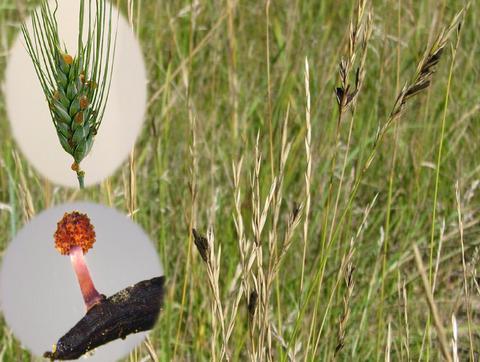当前位置:
X-MOL 学术
›
Ecol. Evol.
›
论文详情
Our official English website, www.x-mol.net, welcomes your
feedback! (Note: you will need to create a separate account there.)
Sympatric divergence of the ergot fungus, Claviceps purpurea, populations infecting agricultural and nonagricultural grasses in North America
Ecology and Evolution ( IF 2.3 ) Pub Date : 2020-12-12 , DOI: 10.1002/ece3.7028 Miao Liu 1 , Parivash Shoukouhi 1 , Kassandra R Bisson 1 , Stephen A Wyka 2 , Kirk D Broders 3 , Jim G Menzies 4
Ecology and Evolution ( IF 2.3 ) Pub Date : 2020-12-12 , DOI: 10.1002/ece3.7028 Miao Liu 1 , Parivash Shoukouhi 1 , Kassandra R Bisson 1 , Stephen A Wyka 2 , Kirk D Broders 3 , Jim G Menzies 4
Affiliation

|
The ergot diseases of agricultural and nonagricultural grasses are caused by the infection of Claviceps spp. (Hypocreales, Ascomycota) on florets, producing dark spur‐like sclerotia on spikes that are toxic to humans and animals, leading to detrimental impacts on agriculture and economy due to the downgrading of cereal grains, import–export barriers, reduced yield, and ecological concerns. At least seven phylogenetic lineages (phylogenetic species) were identified within the premolecular concept of C. purpurea s.l. (sensu lato) in agricultural areas and vicinities in Canada and the Western United States. Claviceps purpurea s.s (sensu stricto) remained as the most prevalent species with a wide host range, including cereal crops, native, invasive, and weedy grasses. The knowledge on genetic diversity and distribution of C. purpurea s.s. in North America is lacking. The objective of the present study was to shed light on genetic differentiation and evolution of the natural populations of C. purpurea s.s. Multilocus DNA sequences of samples from Canada and the Western USA were analyzed using a phylogenetic network approach, and population demographic parameters were investigated. Results showed that three distinct genetically subdivided populations exist, and the subdivision is not correlated with geographic or host differentiations. Potential intrinsic mechanisms that might play roles in leading to the cessation of gene flows among the subpopulations, that is, mating and/or vegetative incompatibility, genomic adaptation, were discussed. The neutrality of two house‐keeping genes that are widely used for DNA barcoding, that is, translation elongation factor 1‐α (TEF1‐α) and RNA polymerase II second largest subunit (RPB2), was challenged and discussed.
中文翻译:

北美麦角真菌、麦角菌、感染农业和非农业牧草的种群的同域分化
农业和非农业牧草的麦角病是由麦角菌属感染引起的。 (子囊菌目、子囊菌门)在小花上,在穗上产生对人类和动物有毒的深色刺状菌核,由于谷物品质下降、进出口壁垒、产量减少和生态环境恶化,对农业和经济造成不利影响。的担忧。在加拿大和美国西部的农业地区和周边地区,在C. purpurea sl(意义)的前分子概念中至少鉴定了七个系统发育谱系(系统发育物种)。麦角菌 ( Claviceps purpurea ss)(严格意义上)仍然是最常见的物种,其寄主范围广泛,包括谷类作物、本土禾本科、入侵禾本科和杂草。关于北美洲C. purpurea ss 遗传多样性和分布的知识缺乏。本研究的目的是阐明C. purpurea ss 自然种群的遗传分化和进化,使用系统发育网络方法分析了加拿大和美国西部样本的多位点 DNA 序列,并研究了种群人口统计参数。结果表明,存在三个不同的遗传细分群体,并且细分与地理或宿主分化无关。讨论了可能在导致亚群之间基因流动停止的过程中发挥作用的潜在内在机制,即交配和/或营养不相容、基因组适应。 广泛用于 DNA 条形码的两个管家基因,即翻译延伸因子 1-α ( TEF 1-α) 和 RNA 聚合酶 II 第二大亚基 ( RPB2 ) 的中性性受到了挑战和讨论。
更新日期:2021-01-08
中文翻译:

北美麦角真菌、麦角菌、感染农业和非农业牧草的种群的同域分化
农业和非农业牧草的麦角病是由麦角菌属感染引起的。 (子囊菌目、子囊菌门)在小花上,在穗上产生对人类和动物有毒的深色刺状菌核,由于谷物品质下降、进出口壁垒、产量减少和生态环境恶化,对农业和经济造成不利影响。的担忧。在加拿大和美国西部的农业地区和周边地区,在C. purpurea sl(意义)的前分子概念中至少鉴定了七个系统发育谱系(系统发育物种)。麦角菌 ( Claviceps purpurea ss)(严格意义上)仍然是最常见的物种,其寄主范围广泛,包括谷类作物、本土禾本科、入侵禾本科和杂草。关于北美洲C. purpurea ss 遗传多样性和分布的知识缺乏。本研究的目的是阐明C. purpurea ss 自然种群的遗传分化和进化,使用系统发育网络方法分析了加拿大和美国西部样本的多位点 DNA 序列,并研究了种群人口统计参数。结果表明,存在三个不同的遗传细分群体,并且细分与地理或宿主分化无关。讨论了可能在导致亚群之间基因流动停止的过程中发挥作用的潜在内在机制,即交配和/或营养不相容、基因组适应。 广泛用于 DNA 条形码的两个管家基因,即翻译延伸因子 1-α ( TEF 1-α) 和 RNA 聚合酶 II 第二大亚基 ( RPB2 ) 的中性性受到了挑战和讨论。











































 京公网安备 11010802027423号
京公网安备 11010802027423号